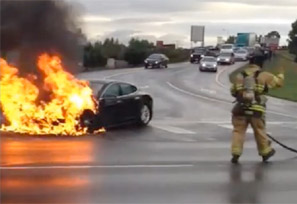Tesla's Musk Blogs to Fight a $600 Million Fire
 Tesla’s shares have been on fire in 2013, soaring more than 400% year to date. While we’ve previously written about the shares strong performance, unfortunately, a fire of a different sort has been associated with the electric car maker recently, after one of its Model S vehicles burst into flames and the incident made it onto Youtube. This unfortunate accident, combined with a negative analyst report earlier that day, led to the stock falling more than 6%, shaving around $600 million from its market cap.
Tesla’s shares have been on fire in 2013, soaring more than 400% year to date. While we’ve previously written about the shares strong performance, unfortunately, a fire of a different sort has been associated with the electric car maker recently, after one of its Model S vehicles burst into flames and the incident made it onto Youtube. This unfortunate accident, combined with a negative analyst report earlier that day, led to the stock falling more than 6%, shaving around $600 million from its market cap.
Tesla though promptly and effectively responded to this turn of events, and likely headed off a potential reputational crisis following what Reuters dubbed “a PR nightmare.”
While Tesla initially offered a holding statement from their head of communications, the company’s CEO, Elon Musk, quickly began communicating why this shouldn’t be viewed as a negative for the company. Specifically, Mr. Musk authored a blog post clearly and transparently explaining what happened, and emphasizing the unique nature of the incident and how the Tesla performed quite well, given the conditions.
Some highlights included:
- The car did not spontaneously combust, quite the opposite, the fire occurred after the vehicle “struck a large metal object,” the geometry of which “caused a powerful lever action as it went under the car, punching upward and impaling the Model S with a peak force on the order of 25 tons.”
- The driver was unharmed and the Tesla’s onboard systems alerted the driver to the problem and directed him to exit the vehicle.
- The fire never entered the passenger cabin.
Musk not only discussed what happened to the beleaguered Tesla, he also compared the accident to what would have happened to a conventional automobile in a similar situation, saying that “the result could have been far worse.” This is because such a vehicle “only has a thin metal sheet protecting the underbody, leaving it vulnerable to destruction of the fuel supply lines or fuel tank, which causes a pool of gasoline to form and often burn the entire car to the ground.”
After quoting some statistics revealing that a driver is “5 times more likely to experience a fire in a conventional gasoline car than a Tesla” Mr. Musk emphatically concludes that “there should be absolutely zero doubt that it is safer to power a car with a battery than a large tank of highly flammable liquid.”
But Mr. Musk’s transparent communications effort doesn’t end there, the post closes with a copy of the company’s correspondence with the driver of the vehicle involved who agrees “that the car performed very well under such an extreme test.”
Tesla shares rose 4.4% the day that Mr. Musk released posted his blog response – showing that the markets appreciate a CEO who can clearly and effectively communicate through a crisis. ![]()
